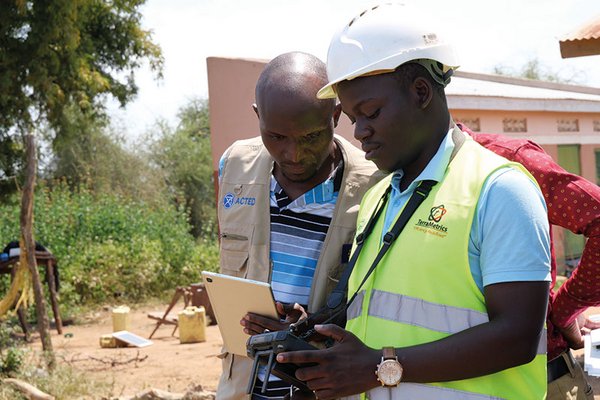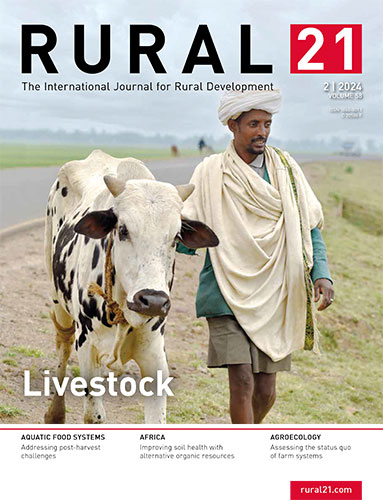 Download this article in magazine layout
Download this article in magazine layout
- Share this article
- Subscribe to our newsletter
Strengthening Uganda’s beef industry through innovation
Globally, the demand of meat and dairy products is expected to grow by more than 60 per cent, with the figure increasing in sub-Saharan countries to 70 per cent – driven by rising incomes and changing dietary preferences. In Uganda, the beef industry is an important contributor to the national food system (see upper Box). However, if action is not taken, the sector will also significantly contribute to greenhouse gas (GHG) emissions levels and this would make it difficult for Uganda to meet its Nationally Determined Contribution commitments for reducing emissions agreed upon with the international community.
Uganda’s livestock sector
According to Uganda’s 2021 National Livestock Census, the livestock sector contributes 4 per cent to the country’s GDP. In all, there are 2.3 million cattle-
keeping households, 34.1 per cent of which are female-headed. The total cattle population amounts to 14.5 million – an increase of nearly 27 per cent compared to 2008. Total milk production is at 71.7 million litres per week. Currently, 77 per cent of Ugandan cattle (11.2 million heads) are indigenous breed while 23 per cent are exotic/cross breed.
Supporting transformation with the SIRGE project
To address the challenges, the EU Delegation to Uganda funded the charity Acted and its partner AgriTechTalk Africa (ATTA) to implement SIRGE (see lower Box). The project’s objective was to foster innovation and access of rural communities and institutions to new technologies for rural transformation through the reduction of greenhouse gas (GHG) emissions and environmental impacts in Uganda’s beef industry, which was to be attained through three main results: 1) enhancing innovation in livestock agriculture, focusing on food and nutrition security; 2) reinforcing the national and regional agricultural research architecture and innovation capacities and promoting multi-stakeholder partnerships for enhanced and long-term impact; and 3) increasing knowledge and evidence-based livestock management practices in adapting to and mitigating climate change in order to feed development policies and investment decisions.
The target areas of implementation were the districts of Nakasongola, in the Central Region of Uganda, and Mbarara, in its Western Region which are part of two of the three main cattle-corridor regions in the country, the other being the Karamoja sub-region.
Calculating methane emissions
First, the consortium partners collected data on livestock body condition in the defined project boundaries and analysed and reviewed current livestock practices such as free range, feedlot and paddock systems. ATTA interviewed a total of 611 farmers (47 women, 564 men) on their livestock management practices (both dairy and beef). The extrapolated data was used to calculate and measure emission factors and emissions from the different project agroecological zones.
These activities were complemented by historic methane emissions calculations from satellite data to select sites for more accurate methane emission analysis using drones. A study was undertaken to research weather conditions and their effects on the GHG emissions in Uganda. Based on the results of a desk review, suitable locations with significant levels of methane emissions were selected for high-resolution in situ surveys from drones. The exercise concluded, as expected, that there was a high spatial methane concentration in areas with livestock farms. Moreover, in areas with lower temperatures and higher humidity, increased methane concentration was observed, while it was lower in areas with higher temperature and reduced humidity. Methane concentration was also higher in sections of the farms where free grazing is done more frequently and in areas with inferior rates of animal manure management. The findings helped to develop an online portal gathering all the produced maps to visualise the result of the data collections.
Setting up a livestock database
In order to analyse the role of grassland/rangeland management on carbon sequestration, in addition to the assessment of pasture management systems during field visits to the farmers, carbon pools below and above the ground were examined. Based on this, appropriate energy coefficients of the various pasture management and grazing practices by animal categories were generated. Project partners also used internal tools of their own creation to collect data on livestock breeds, age, sex, feeding practices and purposes from the above-mentioned farmers (half each in Nakasongola and Mbarara). The findings were used to develop a livestock database with data on livestock characterisation and manure management. The database is a long-term deliverable of the project which will be used to calculate emission factors for each livestock category. To support the utilisation of the database, the project backed the participation of the government, through the Ministry of Water and Environment, in regional and international dialogues on the implementation of livestock coordination frameworks. For instance, at the end of 2021, Acted assisted staff from the Ministry’s Climate Change Department (MWE-CCD) in participating in a bench-marking tour in Nairobi, Kenya, to improve monitoring and reporting on GHG emissions including short-lived climate pollutants (SLCP) and air quality management in Uganda. Following the tour, MWE-CCD developed a partnership with the Climate and Clean Air Coalition (CCAC) of the United Nations Environment Programme (UNEP) to collaborate for reducing SLCPs to protect human health, agriculture and the environment
Identification of mitigation measures
Based on analyses and data evaluations, the following mitigation measures to reduce GHG emissions of the livestock sector were identified: establishing proper manure management systems such as biogas production, utilising improved, highly nutritious pasture with increased yield potential, and keeping improved livestock breeds. For this purpose, the use of low-GHG emitting pastures (Napier grass and Chloris Gayana), the breeding of improved cattle species (Boran, Brahman, Tyrolean grey) and the adoption of agro-forestry and manure management practices was recommended to be supported. The analysis of livestock administration and management at the local and national level resulted in the recommendation of establishing a centralised livestock regulatory framework, the promotion of public-private partnerships and the merging of some governmental agencies whose roles overlap in livestock management.
Fostering the adoption of climate-smart livestock management practices
A range of activities were implemented to increase the adoption of evidence-based livestock management practices to adapt to and mitigate climate change. First of all, indigenous livestock crossbreeding with exotic breeds was promoted to foster a high production and productivity potential. For this purpose, a participatory and exploratory survey among cattle breeders was carried out to obtain data on the available breeds, breeding practices, purpose of each breed and management practices of the available breeds. Subsequently, incentive packages to adopt low emissions intensity breeds were explored. A total of 2,000 semen straws for Brahman, Boran and Tyrolean breeds were distributed to farmers in the districts of Mbarara and Nakasongola at 50 per cent discount. Moreover, qualified artificial insemination technicians in the two districts were identified and trained to assist the farmers in the insemination process and along the cattle’s gestation period.
Advocating for the adoption of the livestock identification and traceability systems guidelines and model policy framework developed by the Intergovernmental Authority on Development (IGAD) was a further measure. Factsheets on proven GHG mitigation technologies and characterised dietary strategies in different beef production systems were developed and disseminated. The project also conducted in vitro trials to determine the GHG emission potential of different pasture/forage ecotypes in GHG emission chambers. Furthermore, in order to favour the adoption of suggested practices, the consortium partners built capacity and carried out awareness-building sessions on the impacts of GHG livestock emissions amongst policy-makers and key sector players.
By the end of the implementation period, three important project goals had been achieved. A database of Ugandan livestock cattle breeds and livestock-related practices had been established, a tool for the forecasting of livestock-related GHG emissions has been created and put at the disposal of the government, and climate-smart livestock practices helping adapt to and mitigate the effects of climate change had been identified. Acted and its partners now aim to build on these results and make a lasting difference in the Ugandan livestock sector towards productivity and environmental sustainability. This requires implementing the identified practices on a larger scale across the above-mentioned cattle-corridor regions and beyond. Recently, the government supported the International Fund for Agricultural Development (IFAD), which submitted an application to the Green Climate Fund to receive funding for a similar project. Acted is looking for funds to finance a second phase of the project, which will be centred more on implementation than research.
The project and its partners
The European Union identified the Ugandan beef industry as a priority value chain that can contribute towards food security and enhance economic development and employment for the country. The project SIRGE – Strengthen an innovative system for the reduction of greenhouse gas emissions and environmental impacts of the nascent beef industry in Uganda in support to rural sustainable transformation – has been implemented by the NGOs Acted and AgriTechTalk Africa in partnership with the Climate Change Department of the Ministry of Water and Environment and the Ministry of Agriculture, Animal Industry and Fisheries, and local implementing partners. The international NGO Acted has been present in Uganda since 2007 and works to address humanitarian, development and environmental issues in the country. ATTA is a Ugandan-registered international NGO that started operations in 2015 and has considerable experience in the field of livestock, crop and food security assessments.
Leonardo Frisani is the Country Project Development Manager of Acted Uganda.
Contact: leonardo.frisani@acted.org





Add a comment
Be the First to Comment